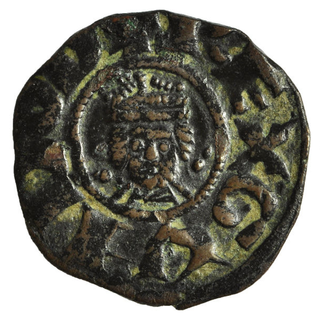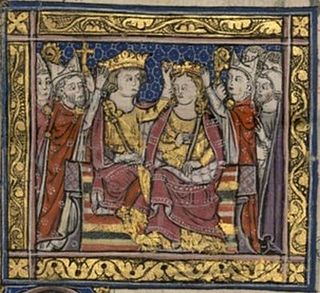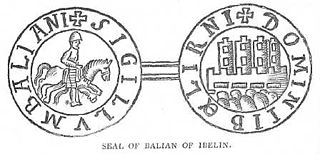Related Research Articles

Aimery of Lusignan, erroneously referred to as Amalric or Amaury in earlier scholarship, was the first King of Cyprus, reigning from 1196 to his death. He also reigned as the King of Jerusalem from his marriage to Isabella I in 1197 to his death. He was a younger son of Hugh VIII of Lusignan, a nobleman in Poitou. After participating in a rebellion against Henry II of England in 1168, he went to the Holy Land and settled in the Kingdom of Jerusalem.

Guy of Lusignan was a French Poitevin knight, son of Hugh VIII of Lusignan and as such born of the House of Lusignan. He was king of Jerusalem from 1186 to 1192 by right of marriage to Sibylla of Jerusalem, and King of Cyprus from 1192 to 1194. Having arrived in the Holy Land at an unknown date, Guy was hastily married to Sibylla in 1180 to prevent a political incident within the kingdom. As the health of his brother-in-law, Baldwin IV of Jerusalem, deteriorated, Guy was appointed by Sibylla as regent for his stepson, Baldwin V of Jerusalem. Baldwin IV died in 1185, followed shortly by Baldwin V in 1186, leading to the succession of Sibylla and Guy to the throne. Guy's reign was marked by increased hostilities with the Ayyubids ruled by Saladin, culminating in the Battle of Hattin in July 1187—during which Guy was captured—and the fall of Jerusalem itself three months later.

Maria of Montferrat (1192–1212) was the queen of Jerusalem from 1205 until her death. Her parents were Isabella I and her second husband, Conrad of Montferrat. Maria succeeded her mother under the regency of her half-uncle John of Ibelin. After him the kingdom was ruled on Maria's behalf by her husband, John of Brienne, whom she married in 1210. She died giving birth to her successor, Isabella II.
Hugh III, also called Hugh of Antioch-Lusignan and the Great, was the king of Cyprus from 1267 and king of Jerusalem from 1268. Born into the family of the princes of Antioch, he effectively ruled as regent for underage kings Hugh II of Cyprus and Conrad III of Jerusalem for several years. Prevailing over the claims of his cousin Hugh of Brienne, he succeeded both young monarchs upon their deaths and appeared poised to be an effective political and military leader.

Henry I of Cyprus, nicknamed the Fat was King of Cyprus from 1218 to 1253. He was the son of Hugh I of Cyprus and Alice of Champagne. When his father Hugh I died on January 10, 1218, the 8-month-old Henry became king. His mother was the official regent, but handed off the actual governing to her uncle, Philip of Ibelin. When Philip died, the effective regency passed to his brother, John of Ibelin, the Old Lord of Beirut.

The Crusader state of the Kingdom of Jerusalem, created in 1099, was divided into a number of smaller seigneuries. According to the 13th-century jurist John of Ibelin, the four highest crown vassals in the kingdom proper were the count of Jaffa and Ascalon, the prince of Galilee, the lord of Sidon, and the lord of Oultrejordain.

The House of Ibelin was a noble family in the Crusader Kingdom of Jerusalem in the 12th century. They rose from humble beginnings to become one of the most important families in the kingdom, holding various high offices and with extensive holdings in the Holy Land and Cyprus. The family disappeared after the fall of the Kingdom of Cyprus in the 15th century.
Baldwin of Ibelin, also known as Baldwin II of Ramla, was an important noble of the Kingdom of Jerusalem in the 12th century and was lord of Ramla from 1169-1186. He was the second son of Barisan of Ibelin, and was the younger brother of Hugh of Ibelin and older brother of Balian of Ibelin. He first appears in the historical record as a witness to charters in 1148.

Balian of Ibelin, also known as Barisan the Younger, was a crusader noble of the Kingdom of Jerusalem in the 12th century. He was lord of Ibelin from 1170 to 1193. As the leader of the defense of the city during the siege of Jerusalem in 1187, he surrendered Jerusalem to Saladin on 2 October 1187.
John of Ibelin, called the Old Lord of Beirut, was a powerful crusader noble in the 13th century, one of the best known representatives of the influential Ibelin family. The son of Balian of Ibelin and the dowager queen Maria Comnena, he had close ties with the nobility of both Cyprus and Jerusalem, since he was the half-brother of Queen Isabella I of Jerusalem. Before he was 20, he was appointed constable of Jerusalem, and a few years later became lord of Beirut. John rebuilt Beirut after Saladin's conquest, and established the grand Ibelin family palace. He served as regent of Jerusalem on behalf of his niece Maria of Montferrat from 1205 to 1210 after her mother, Queen Isabella, died. He was also regent for Isabella's grandson Henry I of Cyprus from 1228 until Henry came of age in 1232. John was known as a principled man, and was seen as the natural leader of the Christian barons in the Holy Land. He resisted the power-seeking of Frederick II, Holy Roman Emperor, in Cyprus, and opposed the imperial forces until King Henry came of age.

The principality of Galilee was one of the four major seigneuries of the crusader Kingdom of Jerusalem, according to 13th-century commentator John of Ibelin, grandson of Balian. The direct holdings of the principality centred around Tiberias, in Galilee proper, but with all its vassals, the lordship covered all Galilee and southern Phoenicia. The independent Lordship of Sidon was located between Galilee's holdings. The principality also had its own vassals: the Lordships of Beirut, Nazareth, and Haifa.

Philip Ι of Montfort, was Lord of La Ferté-Alais and Castres-en-Albigeois 1228–1270, Lord of Tyre 1246–1270, and Lord of Toron aft. 1240–1270. He was the son of Guy of Montfort and Helvis of Ibelin.

Balian III of Beirut was the Lord of Beirut, the second of his family, from 1236, and a son of the famous "Old Lord" John of Ibelin, by his second wife Melisende of Arsuf. From his father he assumed the leadership of the nobility in the War of the Lombards, fought against the agents of the Emperor Frederick II.
Guy of Ibelin, of the Ibelin family, was count of Jaffa and Ascalon during the latter part of the Crusades. He was the son of John of Ibelin and Maria of Barbaron. He was count in name only. His father, John of Jaffa, had died in 1266, after which the fragile truce with the Muslims collapsed, and Jaffa was captured by Baibars in 1268. John was probably succeeded by Guy's older brother James, who held the title of Count of Jaffa until his death in 1276, at which point the title passed to Guy.
Isabella of Ibelin (1252–1282) was lady of Beirut from 1264 until her death in 1282, and also held the title of Queen of Cyprus. She was the daughter of John II of Beirut, lord of Beirut, and of Alice de la Roche sur Ognon.
Isabella of Ibelin (1241–1324) was queen of Cyprus and Jerusalem by marriage to Hugh III of Cyprus.

Melisende was the hereditary Lady of Arsuf from 1177 and the second wife of the powerful nobleman John, Old Lord of Beirut.

Alice de la Roche, Lady of Beirut, Regent of Beirut was the wife of John II, Lord of Beirut in the Kingdom of Jerusalem. She was a daughter of Guy I, Lord of Athens. Alice is sometimes referred to as Alice of Athens. Alice was regent of Beirut for her daughter, Lady Isabella, while Isabella was the queen consort of Cyprus.
Margaret of Antioch-Lusignan, also known as Margaret of Tyre, was an Outremer noblewoman who ruled the Lordship of Tyre in the Kingdom of Jerusalem. A member of the House of Antioch-Lusignan, she married John of Montfort, Lord of Tyre, and was granted rule of the city as widow in 1284. She concluded a truce with the Egyptian sultan Al-Mansur Qalawun and ruled until 1291, when she ceded the lordship and moved to Cyprus.
Guy II or Guido II, surnamed Embriaco, was the lord of Gibelet from about 1271 until his death.
References
- 1 2 3 4 Runciman 1999, p. Appendix III.
- 1 2 Marshall 1992, p. 187.
- ↑ Marshall 1992, p. 176.